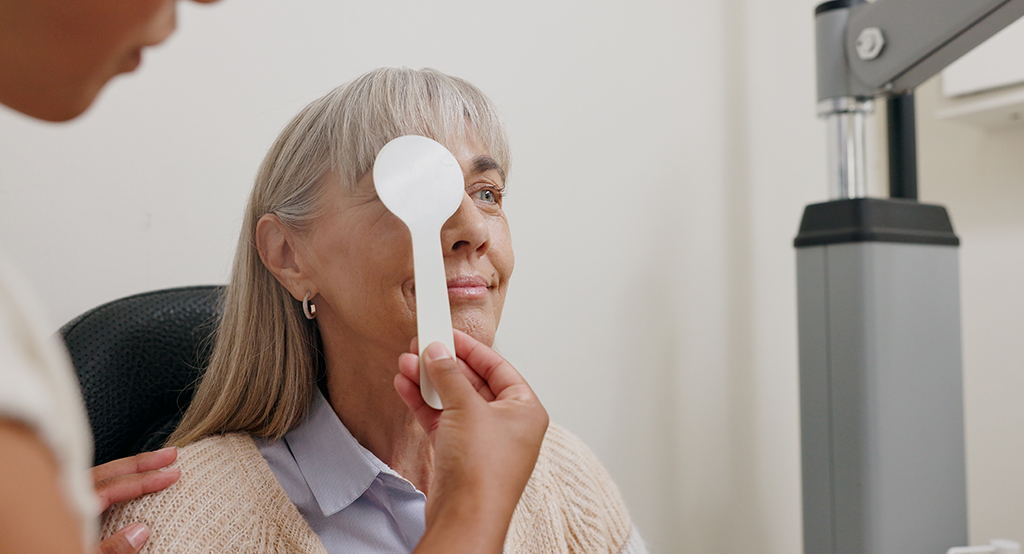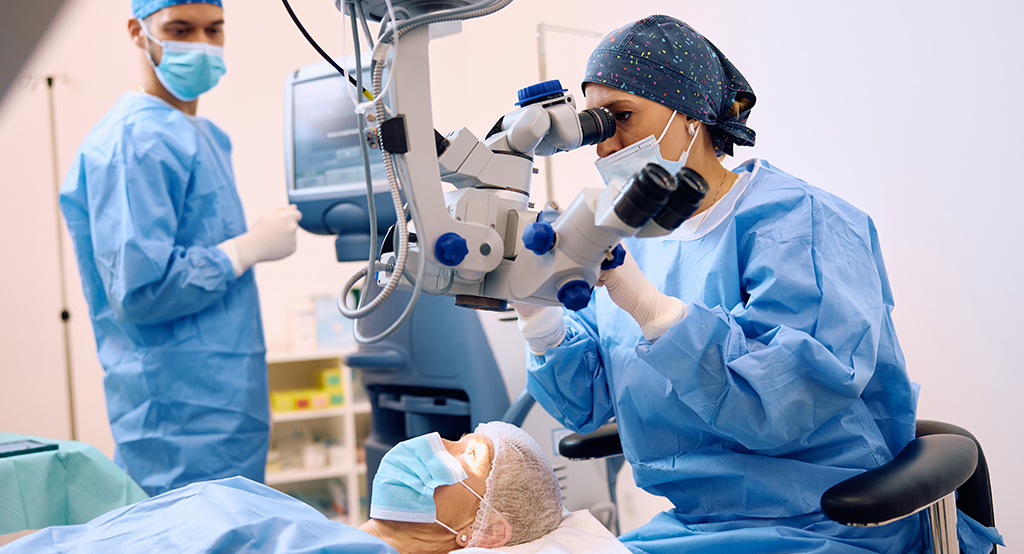Nuclear sclerotic cataracts are one of the most common types of age-related cataracts, which occur when the central portion of the eye’s natural lens – known as the nucleus – becomes hardened (sclerotic) and increasingly cloudy over time. While this process is typically gradual, it can significantly affect vision and quality of life if left untreated.
Understanding Cataracts and the Role of the Lens
The lens of the eye is a transparent, flexible structure located behind the iris. It helps focus light onto the retina, allowing us to see clearly. Over time, the proteins within the lens can start to break down or clump together, leading to cloudiness. When this clouding occurs in the central (nuclear) part of the lens, it is referred to as a nuclear sclerotic cataract.
This condition tends to progress slowly and is usually associated with ageing, although other factors can accelerate its development.
Causes and Risk Factors
Genetics
Genetic predisposition plays a crucial role in the development of nuclear sclerotic cataracts. Individuals with a family history of cataracts are more likely to experience earlier or more severe lens changes. This suggests that inherited variations in lens structure or metabolic processes may affect how the eye handles oxidative stress or protein maintenance over time.
These hereditary factors might influence the integrity of lens proteins or affect the lens’s ability to repair damage. Some families may pass down specific genetic mutations that accelerate the breakdown of proteins within the lens, which in turn can lead to earlier opacification. While this doesn’t guarantee someone will develop cataracts, it can create a higher baseline vulnerability.
Understanding one’s genetic risk allows for more proactive eye care. People with a family history of cataracts should prioritise regular eye examinations and adopt protective measures earlier in life. This may help delay the onset or slow the progression of nuclear sclerotic changes.
Smoking
Smoking introduces a host of harmful substances into the body, many of which contribute to oxidative stress—one of the primary mechanisms behind cataract formation. The lens is especially sensitive to oxidative damage because it lacks a blood supply and relies on internal mechanisms for detoxification and repair. Over time, smoking overwhelms these systems.
Nicotine and other chemicals in tobacco smoke can disrupt the balance of antioxidants within the eye. This imbalance damages lens proteins and accelerates the formation of pigment and cloudiness. Additionally, smoking reduces the levels of protective nutrients, such as vitamin C, that help neutralise oxidative molecules in the eye.
Long-term smokers often experience a faster progression of nuclear sclerotic cataracts compared to non-smokers. The impact is also dose-dependent—the more cigarettes consumed over time, the greater the risk. Fortunately, quitting smoking at any stage can help slow further damage and reduce the likelihood of needing early cataract surgery.

Alcohol
Excessive alcohol intake has been associated with lens degeneration, primarily due to its impact on the liver and nutrient absorption. Alcohol affects how the body processes vital antioxidants like glutathione, which plays a major role in maintaining lens clarity. A deficiency in these protective compounds allows free radicals to build up and damage lens cells.
Beyond oxidative stress, alcohol can also contribute to dehydration, which affects the overall health and flexibility of the lens. Chronic alcohol use disrupts metabolic balance, which may lead to chemical changes in the lens proteins that are difficult to reverse. This sets the stage for hardening and yellowing of the nucleus over time.
Moderate or occasional alcohol consumption may have a less direct impact, but habitual, heavy drinking has been shown to correlate with earlier onset of nuclear sclerotic changes. Reducing alcohol intake not only supports eye health but also benefits overall systemic function, which can help delay age-related conditions.
Prolonged UV Exposure
Extended exposure to ultraviolet (UV) radiation can trigger cellular changes in the lens that promote cataract formation. UV light, particularly UVB, is known to break down lens proteins and disrupt the lens’s ability to maintain transparency. Over many years, this damage accumulates and contributes to sclerosis in the nuclear region.
Outdoor workers and individuals living in sunny climates are especially at risk if protective measures, such as sunglasses or hats, are not used regularly. The lens absorbs UV radiation to protect the retina, but this absorption leads to the formation of reactive oxygen species (ROS), which accelerate tissue damage in the lens.
Fortunately, this risk factor is highly preventable. Wearing sunglasses that block 100% of UVA and UVB rays can significantly reduce long-term damage to the lens. Encouraging UV protection from an early age is one of the most effective public health strategies in slowing the global rise of age-related cataracts.
Diabetes
Diabetes has a profound effect on eye health, including the early onset of cataracts. Elevated blood sugar levels can alter the chemical environment of the lens, leading to the accumulation of sorbitol—a sugar alcohol that causes osmotic stress and water retention in lens cells. This process promotes protein clumping and eventual clouding.
The link between diabetes and cataracts is well-documented, with diabetic individuals being at least twice as likely to develop nuclear sclerotic cataracts compared to those without the condition. Poor glycaemic control increases this risk further, particularly when hyperglycaemia is chronic or poorly managed over several years.
Routine eye examinations are critical for people with diabetes, as they are at higher risk not only for cataracts but also for diabetic retinopathy. Effective management of blood sugar, diet, and lifestyle can help delay the onset and severity of cataracts and preserve vision for longer.

Use of Corticosteroids
Corticosteroids are powerful anti-inflammatory medications, but their long-term use—especially in oral or systemic forms—has been linked to cataract development. These medications can interfere with the normal function of lens epithelial cells, making them more susceptible to oxidative and metabolic stress.
Steroids may alter the composition of lens proteins and impair the lens’s natural ability to repair itself. This results in structural changes and the gradual formation of cloudiness in the nucleus. The risk appears to be highest with prolonged high-dose therapy, particularly when combined with other risk factors like diabetes.
Doctors often weigh the benefits and risks of corticosteroids carefully, particularly in patients with chronic conditions such as asthma, arthritis, or autoimmune disorders. Where possible, minimising dosage or exploring non-steroidal alternatives can help reduce the long-term impact on lens health.
Previous Eye Injuries or Surgeries
Trauma to the eye, whether from blunt force, penetrating injury, or exposure to harmful chemicals, can damage the lens directly or disrupt its supporting structures. Even if the damage seems minor initially, it can trigger a cascade of changes that eventually lead to cataract formation, particularly in the nuclear region.
Eye surgery, while often necessary and beneficial, also carries a risk of cataract development. For example, retinal surgeries or treatments for glaucoma may disturb the delicate balance within the eye, increasing the chances of lens opacification. Surgical trauma or post-operative inflammation can alter the lens’s internal environment.
Protective eyewear in high-risk environments—such as during sports or industrial work—can prevent many of these injuries. Likewise, careful surgical planning and post-operative care are vital in minimising the long-term impact on lens clarity. Individuals with a history of ocular trauma should be monitored closely for early signs of cataracts.

Symptoms of Nuclear Sclerotic Cataracts
Blurry or Hazy Vision
One of the earliest signs of nuclear sclerotic cataracts is a gradual blurring of vision that resembles looking through a foggy window. Unlike sudden vision changes, this blurriness typically develops slowly and may be more noticeable when reading or doing close-up tasks. It often affects both eyes, though one may be worse than the other.
The haze results from the lens becoming less transparent as proteins clump together. This distorts how light passes through the eye and prevents it from focusing sharply on the retina. In the early stages, people often mistake this symptom for needing a new glasses prescription, not realising that the lens itself is the problem.
Over time, the blurriness can worsen, making everyday activities more difficult. People may find it harder to read signs, use computers, or recognise faces from a distance. If left untreated, this symptom alone can significantly reduce a person’s confidence and independence.
Difficulty Seeing at Night, Particularly When Driving
As nuclear sclerotic cataracts progress, night vision tends to deteriorate faster than daytime vision. Low-light conditions make it harder for the eye to adjust, especially when the lens is already clouded. This becomes particularly noticeable when driving at night, where streetlights, oncoming headlights, and dim road markings can become challenging to navigate.
The ageing lens scatters incoming light instead of focusing it, leading to a general dimming of vision. At night, the pupil naturally dilates to let in more light, which also allows more scattered light to enter—exacerbating the effect of the cataract.
This often results in a feeling of being “blinded” by oncoming traffic or unable to see clearly beyond the dashboard.
This symptom can lead to reduced confidence in driving and, in some cases, complete avoidance of night-time travel. For many, it’s the tipping point that prompts them to seek medical advice or consider cataract surgery.
Increased Sensitivity to Glare, Such as from Headlights or Sunlight
Glare sensitivity is a hallmark of nuclear sclerotic cataracts. Individuals often report that bright lights feel overwhelming, painful, or cause visual “halos.” This is because the clouded lens scatters light irregularly, producing visual artefacts that aren’t present with a healthy lens.
Glare becomes particularly disruptive in high-contrast situations, such as walking outdoors on a sunny day or facing oncoming traffic at night. Even light bouncing off shiny surfaces like wet roads or water can cause significant discomfort. Many people find themselves squinting or shading their eyes instinctively in these settings.
This symptom can limit outdoor activities and make working in bright environments very uncomfortable. Wearing polarised sunglasses can provide some relief, but the only long-term solution is to address the cataract itself.
Colours Appearing Faded or Yellowish
Nuclear sclerosis often causes a yellowing or browning of the lens, which filters the light that reaches the retina. As a result, colours begin to lose their vibrancy and contrast. Blues may appear muted, whites look off-white, and everything takes on a slight yellow or brown tint.
These changes are so gradual that they often go unnoticed until someone compares their vision to that of others or undergoes cataract surgery in one eye. After surgery, many patients are surprised by how bright and crisp the world suddenly appears.
This distortion in colour perception can have practical implications, especially for individuals working in design, art, or any field that relies on accurate colour judgement. It may also affect how people interpret their surroundings, influencing things like reading food labels or detecting bruises on the skin.
Frequent Changes in Prescription for Glasses or Contact Lenses
A tell-tale sign of nuclear sclerotic cataracts is the frequent need to update glasses or contact lens prescriptions. The changing shape and density of the lens alters how light is bent as it enters the eye, which can affect both near and distance vision.
Many people initially think their worsening vision is due to refractive error and seek stronger lenses. While this may provide temporary improvement, it doesn’t address the underlying issue—an increasingly opaque lens. Over time, new prescriptions stop making a noticeable difference.
Optometrists often spot this pattern and may refer patients to an ophthalmologist for further evaluation. Once cataracts reach a certain level, glasses alone won’t restore clarity, and surgery becomes the only effective option.
Improved Near Vision in Some Cases – Known as “Second Sight”
Interestingly, some individuals with nuclear sclerotic cataracts experience a temporary improvement in their ability to read or perform tasks up close. This phenomenon, referred to as “second sight,” occurs when the cataract alters the shape of the lens in a way that mimics reading glasses.
Although this may seem like a benefit, it is usually short-lived. As the cataract continues to progress, this brief improvement is followed by a general decline in both near and distance vision. It is often one of the early signs that the lens is undergoing structural changes.
Second sight can be misleading, making some individuals delay seeking care under the impression that their vision is improving naturally. Understanding that this change is typically a precursor to further deterioration is important for timely intervention.
Diagnosis
Visual acuity test – to measure clarity of vision
The visual acuity test is a fundamental part of the diagnostic process for nuclear sclerotic cataracts. It evaluates how clearly a person can see at various distances, often using a standardised eye chart with letters that gradually decrease in size. Patients are asked to read these letters from a fixed distance, usually one eye at a time, to gauge the level of sharpness or blurriness in their vision. This test provides valuable baseline information, particularly in detecting subtle changes that may have gone unnoticed by the individual. A gradual decline in acuity—especially if not corrected by updated lenses—can suggest that the lens is losing transparency. It also helps the clinician determine whether the cataract is significantly affecting daily functioning and whether further evaluation or intervention is needed

Dilated eye exam – where drops are used to widen the pupil for a better view of the lens and retina
During a dilated eye exam, special eye drops are used to enlarge the pupil, allowing the optometrist or ophthalmologist to examine the deeper structures of the eye. This is crucial when assessing the severity and progression of nuclear sclerotic cataracts, as it enables a clear view of the central part of the lens where these cataracts typically form.
By observing the density and colour of the lens through the dilated pupil, the examiner can classify the stage of the cataract and check for any other coexisting eye conditions, such as macular degeneration or diabetic retinopathy. This comprehensive view helps in planning the most appropriate treatment path, particularly if surgery is being considered. Dilation may cause temporary light sensitivity or blurred vision, but it’s a safe and routine procedure.
Tonometry – to check intraocular pressure
Tonometry is used to measure the pressure inside the eye, also known as intraocular pressure (IOP). While this test is more commonly associated with glaucoma screening, it’s still relevant in the context of diagnosing nuclear sclerotic cataracts. Elevated pressure may indicate underlying issues that could complicate cataract treatment or suggest that other eye diseases are present.
The test can be performed using different methods, including a puff of air or a small probe that gently touches the eye. Maintaining normal intraocular pressure is vital for preserving optic nerve health, especially in older adults who are more prone to both cataracts and glaucoma. In some cases, increased IOP may affect decisions around the timing of surgery or the type of intraocular lens to be used during the procedure.
Treatment Options
In the early stages, symptoms of nuclear sclerotic cataracts can often be managed with stronger lighting, updated glasses, and magnifying lenses. However, once the cataract begins to interfere with daily activities such as reading or driving, surgery is usually the recommended course of action.
Cataract Surgery
Cataract surgery is one of the most commonly performed and safest procedures in modern medicine. It involves removing the cloudy natural lens and replacing it with an artificial intraocular lens (IOL). The procedure is typically carried out under local anaesthesia and takes less than an hour.
Modern IOLs come in various forms, including:
- Monofocal lenses – provide clear distance vision but may require reading glasses
- Multifocal lenses – offer both distance and near vision
- Toric lenses – correct astigmatism
The choice of lens depends on individual visual needs and lifestyle.

Post-Surgical Outcomes
Most patients experience significant improvement in vision following cataract surgery, often within just a few days. Full recovery usually takes a few weeks. Complications are rare but may include infection, inflammation, or posterior capsule opacification (PCO), sometimes referred to as a “secondary cataract,” which can be treated with a quick laser procedure.
Prevention and Eye Health
While cataracts cannot always be prevented, there are steps individuals can take to reduce their risk or slow progression:
- Wear sunglasses that block 100% of UV rays
- Maintain a healthy diet rich in antioxidants (e.g. vitamins C and E)
- Avoid smoking and limit alcohol intake
- Manage chronic conditions like diabetes effectively
- Attend regular eye check-ups, especially from the age of 40 onwards
Conclusion
Nuclear sclerotic cataracts are a natural part of the ageing process for many, but they need not lead to permanent vision loss. With regular eye exams and timely treatment – particularly through safe and effective cataract surgery – you can maintain clear vision and a good quality of life well into older age. Early recognition of symptoms and proactive eye care remain key in managing this common condition.

